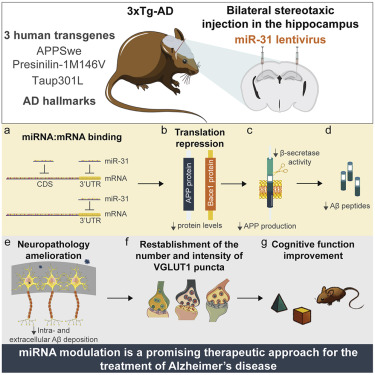当前位置:
X-MOL 学术
›
Mol. Ther. Nucl. Acids
›
论文详情
Our official English website, www.x-mol.net, welcomes your
feedback! (Note: you will need to create a separate account there.)
miRNA-31 Improves Cognition and Abolishes Amyloid-β Pathology by Targeting APP and BACE1 in an Animal Model of Alzheimer’s Disease
Molecular Therapy - Nucleic Acids ( IF 6.5 ) Pub Date : 2020-01-17 , DOI: 10.1016/j.omtn.2020.01.010 Ana Teresa Barros-Viegas 1 , Vítor Carmona 2 , Elisabete Ferreiro 3 , Joana Guedes 3 , Ana Maria Cardoso 1 , Pedro Cunha 4 , Luís Pereira de Almeida 2 , Catarina Resende de Oliveira 5 , João Pedro de Magalhães 6 , João Peça 7 , Ana Luísa Cardoso 3
Molecular Therapy - Nucleic Acids ( IF 6.5 ) Pub Date : 2020-01-17 , DOI: 10.1016/j.omtn.2020.01.010 Ana Teresa Barros-Viegas 1 , Vítor Carmona 2 , Elisabete Ferreiro 3 , Joana Guedes 3 , Ana Maria Cardoso 1 , Pedro Cunha 4 , Luís Pereira de Almeida 2 , Catarina Resende de Oliveira 5 , João Pedro de Magalhães 6 , João Peça 7 , Ana Luísa Cardoso 3
Affiliation

|
Alzheimer’s disease (AD) is the most common form of dementia worldwide, characterized by progressive memory impairment, behavioral changes, and, ultimately, loss of consciousness and death. Recently, microRNA (miRNA) dysfunction has been associated with increased production and impaired clearance of amyloid-β (Aβ) peptides, whose accumulation is one of the most well-known pathophysiological markers of this disease. In this study, we identified several miRNAs capable of targeting key proteins of the amyloidogenic pathway. The expression of one of these miRNAs, miR-31, previously found to be decreased in AD patients, was able to simultaneously reduce the levels of and mRNA in the hippocampus of 17-month-old AD triple-transgenic (3xTg-AD) female mice, leading to a significant improvement of memory deficits and a reduction in anxiety and cognitive inflexibility. In addition, lentiviral-mediated miR-31 expression significantly ameliorated AD neuropathology in this model, drastically reducing Aβ deposition in both the hippocampus and subiculum. Furthermore, the increase of miR-31 levels was enough to reduce the accumulation of glutamate vesicles in the hippocampus to levels found in non-transgenic age-matched animals. Overall, our results suggest that miR-31-mediated modulation of APP and BACE1 can become a therapeutic option in the treatment of AD.
中文翻译:

miRNA-31 通过靶向 APP 和 BACE1 在阿尔茨海默病动物模型中改善认知并消除淀粉样蛋白 - β 病理学
阿尔茨海默病 (AD) 是全世界最常见的痴呆症,其特征是进行性记忆障碍、行为改变,最终导致意识丧失和死亡。最近,微小RNA(miRNA)功能障碍与β淀粉样蛋白(Aβ)肽的产生增加和清除受损有关,其积累是该疾病最著名的病理生理学标志之一。在这项研究中,我们鉴定了几种能够靶向淀粉样蛋白生成途径关键蛋白的 miRNA。其中一种 miRNA miR-31 的表达先前被发现在 AD 患者中降低,但它能够同时降低 17 个月大 AD 三重转基因 (3xTg-AD) 女性海马中 miR-31 的表达水平小鼠的记忆缺陷显着改善,焦虑和认知僵化减少。此外,慢病毒介导的 miR-31 表达显着改善了该模型中的 AD 神经病理学,大大减少了海马和下托中的 Aβ 沉积。此外,miR-31水平的增加足以将海马中谷氨酸小泡的积累减少到非转基因年龄匹配动物中发现的水平。总的来说,我们的结果表明 miR-31 介导的 APP 和 BACE1 调节可以成为治疗 AD 的一种治疗选择。
更新日期:2020-01-17
中文翻译:

miRNA-31 通过靶向 APP 和 BACE1 在阿尔茨海默病动物模型中改善认知并消除淀粉样蛋白 - β 病理学
阿尔茨海默病 (AD) 是全世界最常见的痴呆症,其特征是进行性记忆障碍、行为改变,最终导致意识丧失和死亡。最近,微小RNA(miRNA)功能障碍与β淀粉样蛋白(Aβ)肽的产生增加和清除受损有关,其积累是该疾病最著名的病理生理学标志之一。在这项研究中,我们鉴定了几种能够靶向淀粉样蛋白生成途径关键蛋白的 miRNA。其中一种 miRNA miR-31 的表达先前被发现在 AD 患者中降低,但它能够同时降低 17 个月大 AD 三重转基因 (3xTg-AD) 女性海马中 miR-31 的表达水平小鼠的记忆缺陷显着改善,焦虑和认知僵化减少。此外,慢病毒介导的 miR-31 表达显着改善了该模型中的 AD 神经病理学,大大减少了海马和下托中的 Aβ 沉积。此外,miR-31水平的增加足以将海马中谷氨酸小泡的积累减少到非转基因年龄匹配动物中发现的水平。总的来说,我们的结果表明 miR-31 介导的 APP 和 BACE1 调节可以成为治疗 AD 的一种治疗选择。











































 京公网安备 11010802027423号
京公网安备 11010802027423号